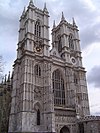List_of_collegiate_churches_in_England
This is a list of collegiate churches in England.
This article has multiple issues. Please help improve it or discuss these issues on the talk page. (Learn how and when to remove these template messages)
|
In Western Christianity, a collegiate church is one in which the daily office[1] of worship is maintained collectively by a college of canons; consisting of a number of non-monastic or "secular clergy"[2] commonly organised by foundation statutes into a self-governing corporate body or chapter, presided over by a dean, warden or provost. In its governance and religious observance a collegiate church is similar to a cathedral, although a collegiate church is not the seat of a bishop and has no diocesan responsibilities. As the primary function of collegiate canons was that of corporate worship, a collegiate church differed in principle from an ordinary parish church whose clergy (even when there might be several of them) had as their primary responsibility the parochial cure of souls. Nevertheless, most medieval collegiate churches also served as parish churches, with the parochial benefice commonly appropriated[3] to the college.
All medieval collegiate churches or chapels would have been endowed at their foundation with income-yielding property, commonly rents or parochial tithes. Under their statutes, each canon would be provided with a distinct income for his personal subsistence; and in England this might be achieved in one of three ways; where the endowments were pooled and each canonry derived a fixed proportion of the annual income, they were termed 'portioners';[4] where each canonry had separate endowments these canonries were termed 'prebends';[5] and where each canonry was provided in the statutes with a fixed stipend[3] income conditional on maintaining prayers and saying masses for the repose of the founder's family, they were classified as 'fellows' or 'chaplains' within a chantry college.[6] In respect of prebends in particular, it became expected practice in the medieval period for canons to be non-resident, vicars being appointed to maintain corporate worship on their behalf, and these vicarages might be specified in the college statutes.[7] Furthermore, in the later medieval period, developing expectations of corporate worship led to collegiate foundations increasingly making provision for professional choirs of singing men (or clerks) and boy choristers. Where a collegiate foundation had appropriated a parish church, the statutes also commonly provided for a parochial vicar.[5]
Prebends were specific to collegiate and cathedral churches; but priests serving non-collegiate parish churches could still be 'portioners' (where each parish priest held a separate rectory, sharing the rectoral endowments of tithe and glebe). Moreover, almost all larger late medieval parish churches housed numerous chantries, whose priests might be organised into a 'college' even though the parish church itself might not have been legally 'appropriated' for collegiate use; and such arrangements may be difficult to distinguish from full collegiate foundations where an intended appropriation had not been carried through. Consequently, there may now be uncertainty in respect of smaller chantry colleges and portioner churches, whether they were indeed collegiate in the medieval period; an uncertainty that is often present in contemporary accounts, as non-collegiate churches with multiple clergy often adopted the forms of worship, nomenclature and modes of organisation of fully collegiate exemplars.[4]
The general division of collegiate endowments into prebends took place in England around the time of the Norman Conquest; and also around the time of the Conquest in the 11th and 12th centuries, the territory of England was being divided into parishes. Prior to the Conquest, there had been considerable numbers of portioner collegiate churches in England, commonly having developed out of Anglo-Saxon minsters or monasteries,[8] and generally without formal statutes. Some of these late Saxon collegiate churches thereafter adopted statutes as prebendary collegiate churches, some continued as portioner collegiate churches, while many ceased collegiate worship altogether, becoming ordinary parish churches. A number were refounded as regular monasteries. Subsequent new collegiate foundations might construct their own dedicated chapel or church, or otherwise might seek to appropriate an existing parish church;[1] although it was not uncommon for such intended appropriations to be stalled, such that the collegiate body then co-existed with a continuing parochial rectory.[9] Consequently, it is not unknown for a collegiate foundation to appropriate the rectory of one parish church; while nevertheless maintaining collegiate worship within another, non-appropriated, church. The majority of these new collegiate foundations were as chantry colleges. The academic colleges of Oxford and Cambridge universities (which developed out of chantry colleges) initially tended to conduct collegiate worship in parish churches in the town, subsequently moving into dedicated chapels.[10]
In the years immediately following the Dissolution of the Monasteries the heads of many English collegiate churches saw it as expedient to surrender their colleges to the crown. Those that did not offer voluntary surrender were mostly compulsorily dissolved by Edward VI in his Abolition of Chantries Act 1547.[11] A few colleges survived the Reformation, specifically the academic colleges, those under the jurisdiction of the monarch, and others who by one device or another escaped the terms of the Tudor legislation. These latter continued until abolished, alongside other sinecures, by the Ecclesiastical Commissioners Act 1840.[12] Eleven former monasteries in England had been refounded under Henry VIII as collegiate churches or cathedrals; some of these were shortly dissolved by Edward VI, others continued. After the Reformation almost all dissolved collegiate churches, including those that had been non-parochial, continued as parish churches and remain so to this day. The commissioners for suppression appointed under the Chantries Act 1547 had been empowered to apply tithes, pensions and annuities so as to establish vicarages in former collegiate churches to provide for cure of souls and maintain parochial worship. Where a collegiate foundation's statutes already provided for a parochial vicar, these continued; but otherwise portions of the tithe sufficient for a competent vicarage might abstracted from the collegiate endowments, the rest being sold to lay impropriators; or otherwise the impropriator might be constrained to establish the vicarage as a perpetual curacy. [13]


